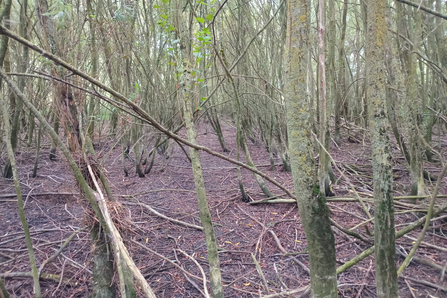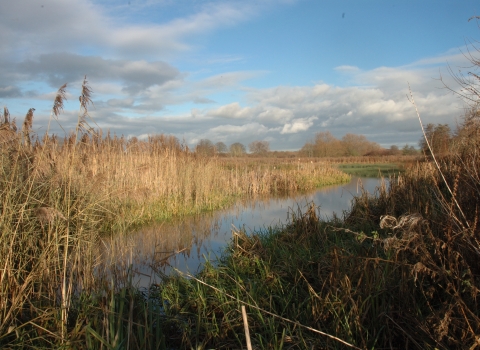Cholsey Marsh scrape management
Cholsey Marsh is a nature reserve of light touch management. The regular flooding and dominant cover of large, rough sedges means that the site is slow to change, but like all human influenced semi-natural landscapes it does change. Nowhere is this more obvious than in the features that were the scrapes, still shown on Ordnance Survey maps as open water.
The reality, however, is quite different. Where there should be depressions acting as seasonal, sunlit water bodies, there is just willow. Willow is quick to take advantage, whipping up and spreading out in the blink of an eye (for a tree). Historically, such crops of willow would have been harvested by humans or, longer ago, beavers, but now they dominate, shading the pools and significantly reducing their value to wetland wildlife.

One of the scrapes at Cholsey Marsh nature reserve, in its current condition over summer
So we’re stepping in this autumn, using the rotary beaver that is the chainsaw blade to fell and pollard, and heavier machinery to remove smaller trees by the root.
The reserve sits on the Thames floodplain, so the trees cannot be left in situ, posing a risk as they would to downstream infrastructure if swept away in a winter inundation. Several approaches to disposing of the wood were investigated, including chipping and removing or burning the wood.
Chipping was the original preferred option, as BBOWT are trying to reduce burning on our reserves. We know it is unpopular due to releasing carbon and particulates. So much better to stack the wood into habitat piles. Unfortunately, due to the floodplain restrictions and the fact that these works are due to produce a lot of wood, this was deemed inappropriate.
When looking into chipping, we realised that not only would the cost of this be significantly higher (2 to 5 times the cost of burning) but we would also cause significantly more disruption to the Fair Mile community, sitting northwest of the reserve. The amount of lorry passes and the continual noise of a large chipper running for several weeks would be distinctly frustrating. Couple this with the fuel required to make the trips and run the additional tools and it became clear that burning was the way to go, in spite of the smoke.
The reduced costs could also be used to undertake other works on the reserve, laying hedges, mending fences and pollarding more trees across the site to ensure their longevity.
As such, while the works are going on, there may be smoke, but it’s smoke that provides a wide variety of species the opportunity of a much more feasible life at our reserve.
Phil Bruss
Mend the Gap Project Officer for BBOWT

